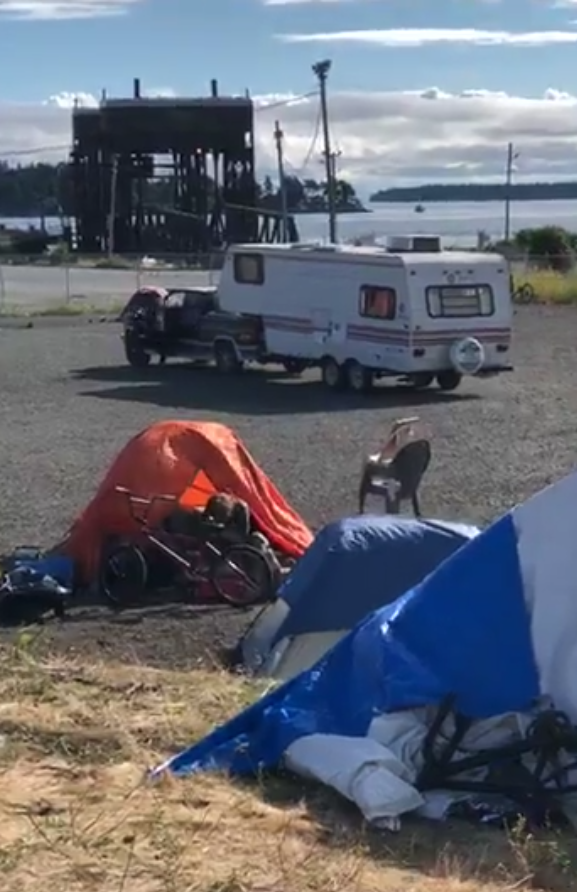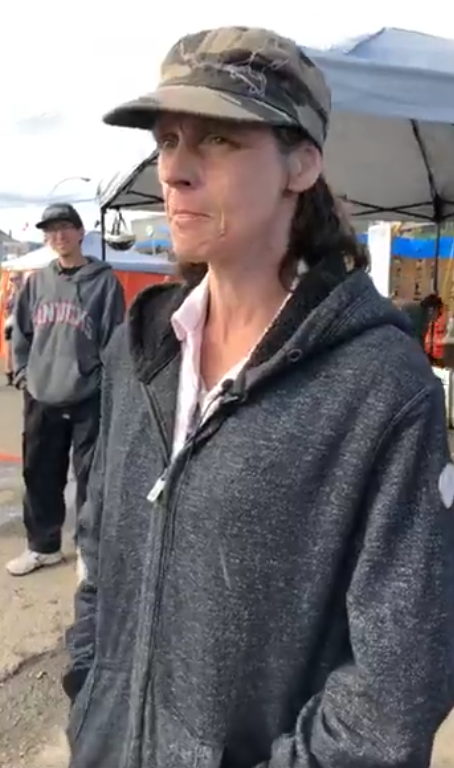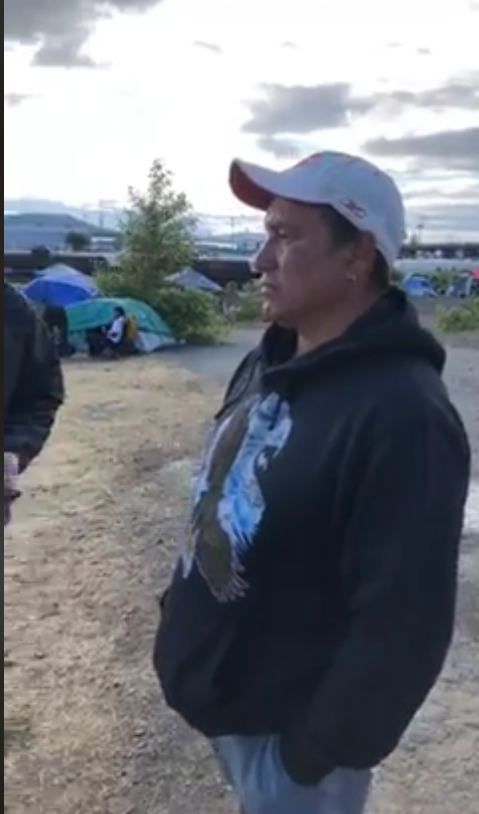
“The City towed my van and it’s all I have in the world”
Nanaimo’s Discontent City throws its gates open to one group of hidden homeless

The homeless count for 2018 reported that there are 350 people living on the streets in Nanaimo. This point-in-time count famously undercounts the number of people living on the street, and it also overlooks the so-called “hidden homeless:” people who are couchsurfing, packed into overcrowded apartments, or living in their cars or vans and forced to illegally park in alleys, parking-lots, and roadsides. On Friday June 15th, Discontent City – the homeless camp in Nanaimo – held a news conference to welcome in homeless people who live in their cars. Since then a dozen living in six cars have parked their mobile homes in the area of camp that residents refer to as “the tarmac,” a large parking lot in the lower part of the sprawling camp.
A month and a half after opening, Discontent City has more than 150 tents and at least 200 residents, with hundreds more who use the camp for some sort of support. At the news conference welcoming car campers into Discontent City, an organizer with the camp, Mercedes Courtorielle, said, “Since we opened the camp about a month ago, we have had people coming in asking if they can move in with their cars. We have one gentleman in his 70s and another elder man who has been living in his car since he was evicted.” Discontent City welcomed this group of hidden homeless into the protection of Discontent City because, Mercedes explained, “They still experience the same sort of harassment and danger that other homeless people do.”

“I have a home, I just don’t have a place to put it”
Cori moved her 5th wheel trailer into camp during the news conference. She bought a 5th wheel trailer when she inherited some money after her father died and moved into it because she could not afford rent. But now, she said, “I’ve found that pad rentals have gone from $400 a month to $300 a week.” And outside of rented camping spots, she says she gets harassed by the RCMP wherever she parks, and then she was robbed. Cori works jobs doing asbestos remediation and traffic control. She has been living out of her trailer, trying to find a place to park it since October. “I can’t take my trailer with me to work. I need somewhere safe to put it and I can’t afford to pay for these new pad rental rates,” she said. “Homelessness does not mean just poverty. It doesn’t even mean you don’t have a home. I have a home, I just don’t have a place to put it.”
Cori says she first came to Discontent City to volunteer and help out. It didn’t occur to her to move in, but she soon saw the value in the community. “In the camp everyone watches each other. I can park my trailer and keep my truck outside for work purposes. It’s pretty awesome to be in a place where I can say hi to my neighbours and feel safe.”
She says that she is part of a group of homeless people who are not visible, so no one thinks of them. People like her live in cars and trailers, and also, she says, “There are still people out there sleeping in boxes, in alley ways.”

“Without tent city we’d be walking around in the streets pushing a shopping cart”
Dereck Paul moved to Nanaimo from Powell River two months ago with his wife. He could not find housing so he started off by staying in a hotel. Then he ran out of money and started crashing with friends. He and his partner moved into a place on Victoria Avenue but the landlord said they were raising the rents by $300 and doing renovations. After that, “we were staying in my van on Victoria street and it got towed away this morning. If it wasn’t for tent city we’d be lost.”
Asked about his desperation of moving from one place to another without ever finding security, he said, “I’m at a loss for words. We’ve had to give away our cats except for one kitten. My wife loves her cats, I’ve never been a cat person but now they’re growing on me. All we have is each other and our van and the one kitten. I have been trying to shovel to keep going. I worked half a day after panhandling and I got heat stroke and I couldn’t keep food down for a week.”
They moved into Discontent City for the support from the community, and the stability of not having to hide from police in their van. “We get a lot of support here. We get good, water, toiletries.”
Dereck and his wife are homeless, Indigenous, and a couple on income assistance; all barriers in the highly competitive rental market. “We can’t find a house here. The prices are outrageous; it’s more than $1,200. As a couple we only get $750, we’d have to put all our food money towards rent. And how can we compete with people who aren’t homeless when we show up and there’s a hundred other people looking for a house?”
Dereck was supposed to move his van into tent city the morning of the news conference but it was impounded the night before. He had a flat tire and left it with a backyard mechanic who said he would give him a deal, and in the night the City had all the vehicles at the mechanic’s impounded. Every day, the cost to get his van out of the tow yard compounded. A week later, camp supporters raised donations to jailbreak the van and Dereck and his wife were able to move out of their tent and into their van down in the Discontent City parking lot. Because of the tent city they found some stability in their van; “Without tent city,” Dereck said, “we’d be walking around in the streets pushing a shopping cart.”
Homeless unity
Welcoming the hidden homeless into Discontent City is a marker of the generosity of the poor.
“The attitude of the camp is the opposite of the City,” Mercedes said. “The City tries to downplay the number of homeless people so they can pretend that a small number of housing units or shelter beds can solve it. The goal of the camp is not to hide homelessness or to get elected on an anti-homeless platform. The goal of the camp is to actually combat the housing crisis by providing a survival space and fighting for the homes we need. The City is not helping them so homeless people have decided to share their resources and open their camp to people living in their cars.” Discontent City is challenging the limits of public perceptions of homelessness, first by taking up space and creating shelter on homeless peoples’ terms, and secondly, by practicing unity amongst homeless people. The unity message from Discontent City is that the camp – as a shelter from anti-homeless hate and displacement and as a site of homeless political power – includes and represents all homeless people, not just those that the police and politicians can see.
